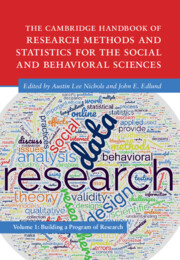 The Cambridge Handbook of Research Methods and Statistics for the Social and Behavioral Sciences
The Cambridge Handbook of Research Methods and Statistics for the Social and Behavioral Sciences from Part I - From Idea to Reality: The Basics of Research
Published online by Cambridge University Press: 25 May 2023
This chapter provides an overview of the processes that are commonly used for analyzing data. Our intention is to explain what these processes achieve and why they are done. Analyzing data goes through four stages. For each stage, we explain the most important concept and then explain the practical steps that are involved. This begins with the data themselves as variables. Next, we move on to describing the data, their variance and covariance, with linear models. Next, we cover interpreting effects and focus on effect sizes. We end with a discussion of inferences about the population and how the presence of uncertainty has to be taken into account in reaching conclusions.
To save this book to your Kindle, first ensure [email protected] is added to your Approved Personal Document E-mail List under your Personal Document Settings on the Manage Your Content and Devices page of your Amazon account. Then enter the ‘name’ part of your Kindle email address below. Find out more about saving to your Kindle.
Note you can select to save to either the @free.kindle.com or @kindle.com variations. ‘@free.kindle.com’ emails are free but can only be saved to your device when it is connected to wi-fi. ‘@kindle.com’ emails can be delivered even when you are not connected to wi-fi, but note that service fees apply.
Find out more about the Kindle Personal Document Service.
To save content items to your account, please confirm that you agree to abide by our usage policies. If this is the first time you use this feature, you will be asked to authorise Cambridge Core to connect with your account. Find out more about saving content to Dropbox.
To save content items to your account, please confirm that you agree to abide by our usage policies. If this is the first time you use this feature, you will be asked to authorise Cambridge Core to connect with your account. Find out more about saving content to Google Drive.